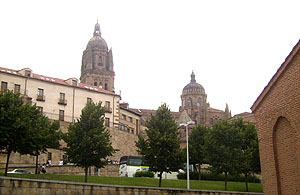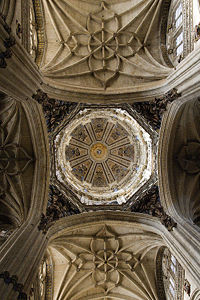
New Cathedral, Salamanca
Encyclopedia


Old Cathedral, Salamanca
The Old Cathedral is one of two cathedrals in Salamanca, Spain, the other being the New Cathedral of Salamanca....
, one of the two cathedral
Cathedral
A cathedral is a Christian church that contains the seat of a bishop...
s of Salamanca
Salamanca
Salamanca is a city in western Spain, in the community of Castile and León. Because it is known for its beautiful buildings and urban environment, the Old City was declared a UNESCO World Heritage Site in 1988. It is the most important university city in Spain and is known for its contributions to...
, Spain
Spain
Spain , officially the Kingdom of Spain languages]] under the European Charter for Regional or Minority Languages. In each of these, Spain's official name is as follows:;;;;;;), is a country and member state of the European Union located in southwestern Europe on the Iberian Peninsula...
. It was constructed between the 16th in and 18th centuries in two styles: late Gothic
Gothic architecture
Gothic architecture is a style of architecture that flourished during the high and late medieval period. It evolved from Romanesque architecture and was succeeded by Renaissance architecture....
and Baroque
Baroque
The Baroque is a period and the style that used exaggerated motion and clear, easily interpreted detail to produce drama, tension, exuberance, and grandeur in sculpture, painting, literature, dance, and music...
. Building began in 1513 and the cathedral was consecrated
Consecration
Consecration is the solemn dedication to a special purpose or service, usually religious. The word "consecration" literally means "to associate with the sacred". Persons, places, or things can be consecrated, and the term is used in various ways by different groups...
in 1733. It was commissioned by Ferdinand V of Castile
Ferdinand II of Aragon
Ferdinand the Catholic was King of Aragon , Sicily , Naples , Valencia, Sardinia, and Navarre, Count of Barcelona, jure uxoris King of Castile and then regent of that country also from 1508 to his death, in the name of...
of Spain. It was declared a national monument by royal decree in 1887.
Architectural style

Renaissance
The Renaissance was a cultural movement that spanned roughly the 14th to the 17th century, beginning in Italy in the Late Middle Ages and later spreading to the rest of Europe. The term is also used more loosely to refer to the historical era, but since the changes of the Renaissance were not...
style, giving the resulting Plateresco style
Plateresque
Plateresque, meaning "in the manner of a silversmith" , was an artistic movement, especially architectural, traditionally held to be exclusive to Spain and its territories, which appeared between the late Gothic and early Renaissance in the late 15th century, and spread over the next two centuries...
in Spain
Spain
Spain , officially the Kingdom of Spain languages]] under the European Charter for Regional or Minority Languages. In each of these, Spain's official name is as follows:;;;;;;), is a country and member state of the European Union located in southwestern Europe on the Iberian Peninsula...
. However, this cathedral retained more of its Gothic character because the authorities wanted the new cathedral to blend with the old one. Thus the new cathedral was constructed, continuing with Gothic style during the 17th and 18th centuries. However, during the 18th century, two elements were added that broke with the showy form with the predominant style of the building: a Baroque cupola
Cupola
In architecture, a cupola is a small, most-often dome-like, structure on top of a building. Often used to provide a lookout or to admit light and air, it usually crowns a larger roof or dome....
on the transept
Transept
For the periodical go to The Transept.A transept is a transverse section, of any building, which lies across the main body of the building. In Christian churches, a transept is an area set crosswise to the nave in a cruciform building in Romanesque and Gothic Christian church architecture...
and the final stages of the bell tower
Bell tower
A bell tower is a tower which contains one or more bells, or which is designed to hold bells, even if it has none. In the European tradition, such a tower most commonly serves as part of a church and contains church bells. When attached to a city hall or other civic building, especially in...
(92 m). The new cathedral was constructed without the subsequent destruction of the old cathedral as normally happened but a wall of the new cathedral, leans on the North wall of the old one. For this reason, the old cathedral had to be reinforced, and the bell tower was constructed on the old one. Two of the main architects of the cathedral were J. Gil de Hontañón and his son Rodrigo in 1538.
Its main entrance consists of 3 arcs, each leading to the 3 naves (sections) of the church. All three are richly carved. Among the ornate carvings on the façade is the incongruous likeness of an astronaut floating in space; it was added by an artist during restoration work in 1992 as a symbol of the 20th century.
Restoration after the Lisbon earthquake
Cracks and the broken windows are visible reminders of the devastating effects of the Lisbon Earthquake, that took place on November 1, 1755, which are still visible today. After the earthquake, repairs were necessary to the cupola and the base of the tower which were reinforced with a lining of lines of sillares, in form of a pyramid trunk that spoiled the basic profile of the tower (This tower is a virtual twin of the tower of the cathedral of SegoviaSegovia Cathedral
Segovia Cathedral is a Roman Catholic religious building in Segovia, Spain. It is located in the main square of the city, the Plaza Mayor, and is dedicated to the Virgin Mary....
). The moment of this catastrophe is commemorated with the "Mariquelo" tradition on October 31, when every year residents climb to the cupola high above and play flutes and drums.

